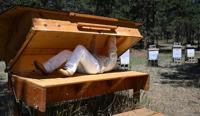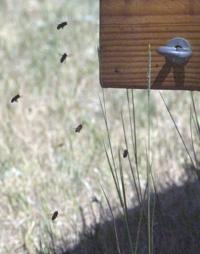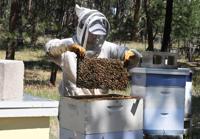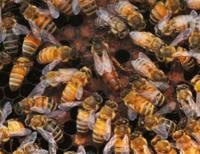Beekeeper and shaman: How bees became sacred for Colorado Springs woman
Beekeeper and shaman: How bees became sacred for Colorado Springs woman
Within Black Forest, scattered with trees to shade from the summer sun, stands four pillars of containers propped up by breeze blocks. Near it, a human-sized wooden box.
If you stand there, quiet and still, tuning out the chirping birds or whistling breeze, you’ll hear a low hum. A buzzing. The sound of hundreds of thousands of honey- bees.
The murmur of the black and yellow striped drones is Samantha Halbrook’s peace.
Halbrook isn’t your standard beekeeper, though. She’s also a shamanic practitioner.
Her apiary, Honey Bee You, incorporates shamanic practices with beekeeping. Halbrook offers three services: traditional tours of the hives, shamanic energy work with the bees and bee bed immersion — more on that later.

Samantha Halbrook climbs into a “bee bed” at her apiary, Honey Bee You, in Black Forest.
“From a shamanic standpoint, when you talk about honeybees, or animals in general, they each have their own individual energy signature and wisdom to them,” Halbrook said. “Unlocking that ability to kind of see how it really works and unfolds in greater capacities was just kind of like, OK, that’s the key.”
Beekeeping was Halbrook’s original passion. She became interested in it eight years ago, after a swarm of bees settled into her parents’ barn. Looking to remove the bees without extermination, the family hired a hobbyist beekeeper to rehome them.
“I asked if I could tag along. I’d always been interested in bees and had a connection with bugs, I guess. So, he let me tag along,” Halbrook said. “It was the scariest thing I’d ever done in my life up to that point — and I totally fell in love.”
That was Halbrook’s introduction to bees. She became fascinated by the way the insects work.
“They communicated so well, even in times of distress,” Halbrook said. “It broke my heart a little bit to see that we were moving these creatures out of a place that they worked so hard to build and create such special energy around. But also, that we could provide a safe space for them where they could still do their thing and be happy.”

Bees fly in and out of the bee bed at the Honey Bee You in Black Forest. Halbrook offers three services at her apiary: traditional tours of the hives, shamanic energy work with the bees and bee bed immersion.
The following season, Halbrook worked with the beekeeper to learn more, and has practiced beekeeping since.
“When I’m out here, visiting with the bees or taking care of them, it’s just such a feeling of fullness and alignment with my purpose,” Halbrook said.
Halbrook maintains her hives without chemicals. Its not uncommon for beekeepers to use acids to manage varroa mites, which are parasitic to honeybees. To mitigate this problem, she instead uses thermal heat treatments that kill the mites or make them unable to reproduce.
As for Halbrook’s spiritual practices, she became interested in shamanism in 2018, after her sister found support from a practitioner for depression.
“The shaman transformed my sister’s life just completely and was able to help her in ways that she wasn’t able to find on her own or through different modalities,” Halbrook said. “That was my first introduction to there being something more to spirituality than just prayer.”
Seeing the impact shamanism had on her sister’s life, Halbrook decided to learn more. After reading Simon Buxton’s “The Shamanic Way of the Bee”, she was even more inspired to start her spiritual practice, Halbrook said, finding that she could incorporate her work as a beekeeper.
“I didn’t have any skill sets that I know could help her. I’m not a doctor. I’m not a psychologist. I’m not a therapist. Those aren’t my zones of genius, but beekeeping is,” Halbrook said. “This is perfectly combining what I’m able to provide, my zone of genius and beekeeping and a way that I can help not only my sister potentially, but also the community and something I believe in passionately.”

Samantha Halbrook holds up a bee-filled frame from one of her hives at her apiary, Honey Bee You, in Black Forest.
Halbrook became serious about her practice in 2020, studying the shamanic traditions of the Peruvian Q’ero tribe. She learned from Jerri Doran, an initiated practitioner in Salida.
Halbrook focuses on energy work, and believes that the frequencies bees operate at work well with her spiritual practice.
“Bees are very interesting creatures, because they prefer locations of higher frequency,” she said. “Typically, organisms don’t prefer those higher electromagnetic frequencies. But honeybees and ants are the outlier to that, and they actually thrive in places like that. So between them being just a little odd on that scale, and then the energy work, I thought that just tied really well together.”
That’s where the bee bed comes in. The bee bed is a contained wooden structure, similar in size and style to a tanning bed, that is set up for the user to lie down upon beehives. Don’t worry about stings, though — the bed portion is separated from the hives by thick, wooden boards.
Halbrook built the bee bed with her father-in-law, and considers the vibrational hymns of the bees from within the bed a way to relax, meditate or potentially heal from certain ailments, similar to the concept of Tibetan singing bowls. The idea behind the immersion, Halbrook said, is to be in close proximity to the bees to come into resonance with their natural frequency.
“The bee bed is an opportunity to step into that place, come into coherence with the honeybees and experience those additional modalities,” she said.
“We transmute the energies that maybe aren’t serving your highest good.”
Halbrook also shares belief that the closeness to the bees can provide a form of aromatherapy, potentially helping the respiratory system.
The bee bed is inspired by bee houses — wooden huts with beehives surrounding the exterior — popular in Eastern Europe. In countries like Germany, Hungary, Slovenia and Austria, beehive air therapy is used in traditional medicine to potentially combat lung ailments.

Honey Bee You in Black Forest. Samantha Halbrook offers three services at her apiary: traditional tours of the hives, shamanic energy work with the bees and bee bed immersion. Thursday, July 18, 2024.
As opposed to honey, very little — if any — research has been conducted around the connection between honeybees and human health, whether that be aromatics or sound frequencies. Because of the lack of studies, medical experts will not say to what degree the immersion therapy may or may not work.
Elizabeth McConnell, an entrepreneur in Colorado Springs, has visited Halbrook for several energy work sessions throughout the years. McConnell admires Halbrook’s deep reverence for the bees she works with, as well as her shamanistic practice.
“It was one of the most powerful things I’ve experienced,” McConnell said. “I was able to access some pretty deep layers of different things that I had experienced or was experiencing at the time that I hadn’t really been able to get to on my own.”
As for the bee bed, McConnell remembers the first time she laid in it.
“It was really fascinating, and I was able to really connect into my body in a way that I hadn’t before,” McConnell said.
Having a fear around bees, immersing herself in the bed was scary for McConnell. But, as Halbrook talked her through it, she was able to work through her fears.
“Laying in the bee bed and sitting with Sam and just having her kind of talk through all of it with me, it was really a beautiful way to be able to work through that fear in a safe way and to feel supported,” McConnell said. “I think it translated not only to like that fear, but also other fears that I was maybe holding on to.”
Halbrook does warn visitors not to try the bee bed if they’re claustrophobic, since it’s an enclosed space.
“Some people are able to relax right away, and they say, ‘Wow, I really wish that I had more time in there because it was so relaxing and so great,’” Halbrook said. “Then the other half of people are saying, ‘I can’t get my mind to calm down. It was plenty of time.’ So I think that just depends on how easily you can relax your nervous system and really come into a meditative state.”
For Halbrook, people come seeking different things from the bee bed — whether just a moment of relaxation and meditation, or deeper spiritual healing.
“I think it depends on what the individual’s perspective is and what they want to get out of it,” Halbrook said.
“I have a lot of people that come do hive tours that are scared of bees, and they’re just trying to get that fear worked through. And then I have other people that come out who are looking for guidance in some way — universe, spirit, God — whatever they’re familiar with. And this is a great opportunity to find that quiet space that we lack in our everyday lives.”





대화 참여하기